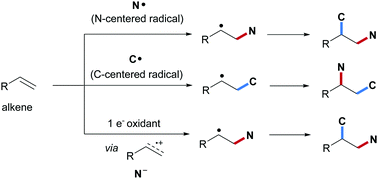当前位置:
X-MOL 学术
›
Chem. Soc. Rev.
›
论文详情
Our official English website, www.x-mol.net, welcomes your feedback! (Note: you will need to create a separate account there.)
Intermolecular radical carboamination of alkenes.
Chemical Society Reviews ( IF 46.2 ) Pub Date : 2020-02-14 , DOI: 10.1039/c9cs00692c Heng Jiang 1 , Armido Studer
Chemical Society Reviews ( IF 46.2 ) Pub Date : 2020-02-14 , DOI: 10.1039/c9cs00692c Heng Jiang 1 , Armido Studer
Affiliation

|
Vicinal alkene carboamination is a highly efficient and practical synthetic strategy for the straightforward preparation of diverse and valuable amine derivatives starting from simple compounds. During the last decade that approach has found continuous research interests and various practical methods have been developed using transition-metal catalysis. Driven by the renaissance of synthetic radical chemistry, intermolecular radical alkene carboamination comprising a C-C bond and a C-N bond forming step has been intensively investigated recently culminating in novel strategies and improved protocols which complement existing methodologies. Radical alkene carboamination can be achieved via three different reaction modes. Such cascades can proceed through N-radical addition to an alkene with subsequent C-C bond formation leading to 2,1-carboamination products. Alternatively, the C-C bond can be installed prior to the C-N bond via initial C-radical addition to the alkene with subsequent β-amination resulting in 1,2-carboamination. The third mode comprises initial single electron oxidation of the alkene to the corresponding alkene radical cation that gets trapped by an N-nucleophile and the cascade is terminated by radical C-C bond formation. In this review, the three different conceptual approaches will be discussed and examples from the recent literature will be presented. Further, the reader will get insights into the mechanism of the different transformations.
中文翻译:

烯烃的分子间自由基碳氨基化。
邻烯烃碳氨化是一种高效,实用的合成策略,用于从简单化合物开始直接制备各种有价值的胺衍生物。在过去的十年中,该方法引起了持续的研究兴趣,并且已经使用过渡金属催化技术开发了各种实用的方法。在合成自由基化学的复兴的推动下,最近已对包含CC键和CN键形成步骤的分子间自由基烯烃碳氨化进行了深入研究,最终形成了新颖的策略和改进的方法,以补充现有方法。自由基烯烃碳氨基化可以通过三种不同的反应模式实现。这种级联反应可以通过将N自由基加成到烯烃中,随后形成CC键而导致,1-碳化产品。可替代地,可以通过将初始的C-自由基加成至烯烃并随后的β-氨基化导致1,2-碳氨基化来将CC键安装在CN键之前。第三种模式包括烯烃初始被单电子氧化成被N-亲核试剂捕获的相应的烯烃自由基阳离子,并且级联被自由基CC键形成终止。在这篇综述中,将讨论三种不同的概念方法,并提供来自最近文献的例子。此外,读者还将深入了解不同转换的机制。第三种模式包括烯烃初始被单电子氧化成被N-亲核试剂捕获的相应的烯烃自由基阳离子,并且级联被自由基CC键形成终止。在这篇综述中,将讨论三种不同的概念方法,并提供来自最近文献的例子。此外,读者还将深入了解不同转换的机制。第三种模式包括烯烃初始被单电子氧化成被N-亲核试剂捕获的相应的烯烃自由基阳离子,并且级联被自由基CC键形成终止。在这篇综述中,将讨论三种不同的概念方法,并提供来自最近文献的例子。此外,读者还将深入了解不同转换的机制。
更新日期:2020-03-24
中文翻译:

烯烃的分子间自由基碳氨基化。
邻烯烃碳氨化是一种高效,实用的合成策略,用于从简单化合物开始直接制备各种有价值的胺衍生物。在过去的十年中,该方法引起了持续的研究兴趣,并且已经使用过渡金属催化技术开发了各种实用的方法。在合成自由基化学的复兴的推动下,最近已对包含CC键和CN键形成步骤的分子间自由基烯烃碳氨化进行了深入研究,最终形成了新颖的策略和改进的方法,以补充现有方法。自由基烯烃碳氨基化可以通过三种不同的反应模式实现。这种级联反应可以通过将N自由基加成到烯烃中,随后形成CC键而导致,1-碳化产品。可替代地,可以通过将初始的C-自由基加成至烯烃并随后的β-氨基化导致1,2-碳氨基化来将CC键安装在CN键之前。第三种模式包括烯烃初始被单电子氧化成被N-亲核试剂捕获的相应的烯烃自由基阳离子,并且级联被自由基CC键形成终止。在这篇综述中,将讨论三种不同的概念方法,并提供来自最近文献的例子。此外,读者还将深入了解不同转换的机制。第三种模式包括烯烃初始被单电子氧化成被N-亲核试剂捕获的相应的烯烃自由基阳离子,并且级联被自由基CC键形成终止。在这篇综述中,将讨论三种不同的概念方法,并提供来自最近文献的例子。此外,读者还将深入了解不同转换的机制。第三种模式包括烯烃初始被单电子氧化成被N-亲核试剂捕获的相应的烯烃自由基阳离子,并且级联被自由基CC键形成终止。在这篇综述中,将讨论三种不同的概念方法,并提供来自最近文献的例子。此外,读者还将深入了解不同转换的机制。



























 京公网安备 11010802027423号
京公网安备 11010802027423号